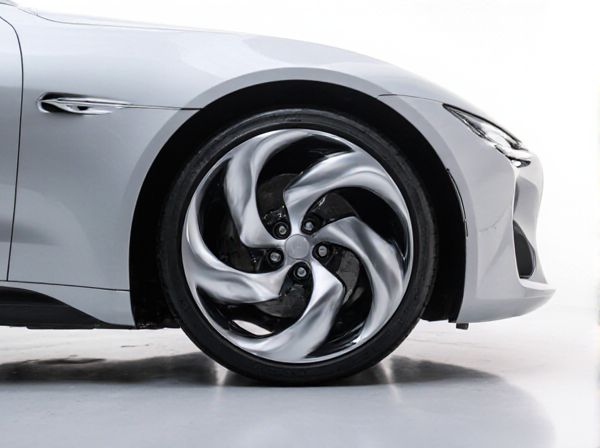
Photo illustration: Flow-formed Wheels vs Gravity-cast Wheels
Flow-formed wheels offer enhanced strength and reduced weight due to the high-pressure forming process that elongates the aluminum grain structure, resulting in improved performance and fuel efficiency. Gravity-cast wheels are typically less expensive but heavier and more prone to cracks or bends under stress because the metal is poured into molds without additional shaping. Your choice depends on whether you prioritize cost savings or durability and performance in demanding driving conditions.
Table of Comparison
| Feature | Flow-formed Wheels | Gravity-cast Wheels |
|---|---|---|
| Manufacturing Process | Aluminum alloy is heated and stretched over a mold using high pressure. | Molten aluminum poured into molds using gravity. |
| Strength | Higher tensile strength due to metal grain alignment. | Lower strength; more prone to cracks under stress. |
| Weight | Lighter weight, improving vehicle performance and fuel efficiency. | Heavier compared to flow-formed wheels. |
| Cost | More expensive due to complex manufacturing. | More affordable and widely available. |
| Durability | Superior durability and resistance to impact damage. | Less durable, susceptible to bending or cracking. |
| Common Use | High-performance vehicles, sports cars, and luxury models. | Economy cars and standard daily drivers. |
Introduction to Flow-formed and Gravity-cast Wheels
Flow-formed wheels are manufactured using a rolling process that stretches and compresses the aluminum alloy, resulting in enhanced strength and reduced weight compared to gravity-cast wheels. Gravity-cast wheels are produced by pouring molten aluminum into molds, relying on gravity without additional pressure, which typically results in a more affordable but heavier and less durable wheel. The distinct manufacturing techniques directly impact the performance, durability, and cost-effectiveness of flow-formed versus gravity-cast wheels.
Manufacturing Process Overview
Flow-formed wheels utilize a high-pressure rolling technique after casting that stretches and compresses the aluminum alloy, enhancing tensile strength and reducing weight without sacrificing durability. Gravity-cast wheels are produced by pouring molten aluminum into molds under gravity, resulting in wheels with denser microstructures but generally higher weight and less mechanical strength than flow-formed wheels. The flow-forming process creates a refined grain structure and improved mechanical properties through controlled deformation and heat treatment, making it superior in performance to the simpler casting method.
Material Strength and Durability Comparison
Flow-formed wheels exhibit superior material strength due to the metal stretching and compressing during the manufacturing process, enhancing the grain structure and resulting in a denser, more durable wheel compared to gravity-cast wheels. Gravity-cast wheels, produced by pouring molten aluminum into molds, typically have lower tensile strength and a higher likelihood of porosity and imperfections, making them less resilient under stress. Consequently, flow-formed wheels offer improved fatigue resistance and impact durability, making them ideal for performance and long-term usage scenarios.
Weight Differences and Performance Impact
Flow-formed wheels exhibit a significant weight reduction compared to gravity-cast wheels due to their manufacturing process, which stretches and compresses the aluminum alloy for enhanced strength. This weight difference, often around 15-20%, contributes to lower unsprung mass, improving acceleration, braking, and overall handling performance. The improved rigidity of flow-formed wheels enhances cornering stability and reduces fatigue, making them a preferred choice for high-performance and racing applications.
Design Flexibility and Aesthetic Options
Flow-formed wheels offer enhanced design flexibility compared to gravity-cast wheels, as the flow-forming process allows thinner spokes and more intricate patterns while maintaining strength and durability. Gravity-cast wheels typically have thicker designs due to the casting limitations, restricting aesthetic options and detail complexity. This results in flow-formed wheels providing a broader range of customizable finishes and styles, appealing to enthusiasts seeking unique and visually striking wheel designs.
Cost Analysis: Flow-formed vs Gravity-cast
Flow-formed wheels typically have higher upfront manufacturing costs due to the advanced machinery and processes required, but they offer better strength-to-weight ratios which can reduce long-term expenses such as fuel consumption and tire wear. Gravity-cast wheels are more cost-effective to produce initially, leveraging simpler casting methods, but they tend to be heavier and less durable, potentially increasing maintenance and replacement costs over time. Evaluating total cost of ownership, flow-formed wheels often provide superior value despite their premium price, especially in performance and efficiency contexts.
Real-world Applications and Suitability
Flow-formed wheels exhibit superior strength-to-weight ratios, making them ideal for high-performance sports cars and racing applications where durability and weight reduction are critical. Gravity-cast wheels, while more cost-effective, are better suited for everyday passenger vehicles and general use due to their adequate strength and affordability. Real-world applications demonstrate that flow-formed wheels excel in environments demanding enhanced mechanical performance, whereas gravity-cast wheels fulfill the needs of budget-conscious drivers prioritizing reliability and maintenance ease.
Maintenance and Longevity Considerations
Flow-formed wheels offer enhanced structural integrity and durability due to their manufacturing process, resulting in reduced maintenance requirements compared to gravity-cast wheels. Gravity-cast wheels, while more affordable, tend to be more susceptible to cracking and corrosion, often necessitating more frequent inspections and repairs. Prioritizing flow-formed wheels can lead to longer service life and lower long-term maintenance costs in high-performance or demanding driving conditions.
Environmental Impact and Sustainability
Flow-formed wheels exhibit a lower environmental impact compared to gravity-cast wheels due to their energy-efficient manufacturing process, which uses less raw material while maintaining strength and durability. The enhanced structural integrity of flow-formed wheels extends their lifespan, reducing the frequency of replacements and thus decreasing waste generation. Gravity-cast wheels typically consume more energy and resources during production, resulting in a larger carbon footprint and less sustainable lifecycle.
Choosing the Right Wheel Type for Your Needs
Flow-formed wheels offer superior strength and lightweight performance due to the high-pressure forming process, making them ideal for drivers seeking enhanced durability and improved handling. Gravity-cast wheels are more affordable and suitable for everyday use, providing adequate strength for normal driving conditions without the premium cost. Selecting between flow-formed and gravity-cast wheels depends on your budget, driving style, and performance requirements, with flow-formed wheels favored for high-performance applications and gravity-cast wheels recommended for cost-effective reliability.
 caratoz.com
caratoz.com